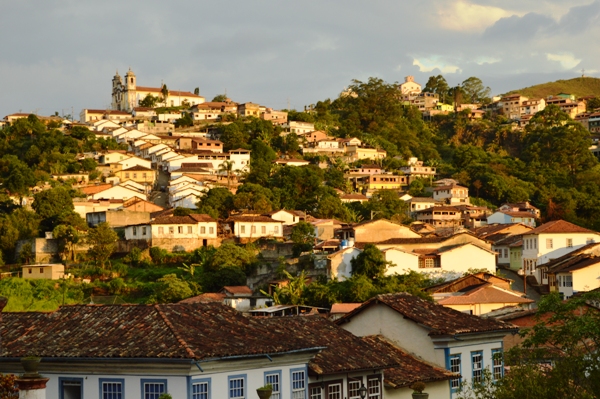We’ll all have our fill of Brazil and football this summer, but my first exposure to this obsession was not a happy one. We were on our way to Ouro Preto and thanks to a late flight decided to spend the night in Belo Horizonte, the main city in the state of Minas Gerais. What I hadn’t planned was that our arrival would coincide with the local football team Cruzeiro winning the Brazilian league that evening. Our carefully-chosen central hotel turned out to be directly above the square in which the impromptu all-night celebrations took place. Car horns, fire crackers and singing flooded the night air and even our 19th-floor location couldn’t spare us from the relentless din that was still in full swing at 6am.
So it was with heavy heads that we arrived in Ouro Preto the next morning and began our assault on its mountainous cobbled streets. Thankfully Ouro Preto is a town so grand that even a sleepless night is soon forgotten.
1 in 3 gradients drop from both sides of Praça Tiradentes, the town’s central square and pretty much the only flat place in the whole town. A walk anywhere in Ouro Preto is guaranteed to provide a good work-out. Yet it is this punishing geography that has made Ouro Preto probably the single most important town in Brazilian history. The gold found in the hills of the town and nearby brought great wealth to many people and helped fund Europe’s Industrial Revolution.
In the early 1700s as the gold rush attracted thousands of prospectors to Ouro Preto, a significant chunk of the loot was directed to the authorities and the church. Whatever the moral issues around the money that flowed as a result of the gold (and there are many) what is in no doubt is that the resulting Baroque buildings were some of the world’s finest at the time and thankfully they have largely been carefully preserved.
I visit the Church of St Francis, best known as the crowning work of Aleijadinho, Ouro Preto’s most celebrated craftsman. I’m quite surprised to hear that his nickname was ‘The Little Cripple’ and learn that he was probably riddled with arthritis. Not only was he disadvantaged by his disability but as the son of a slave mother he was not allowed to have his name displayed on his work. He masterminded the building of the St Francis church and was responsible for the many elaborate carvings, made from locally-sourced soapstone.
At the other side of town the Nossa Senhora de Pilar church is the epitomy of opulence and tells many a story about the influence of the church in the gold rush years. Dripping with a reported 480 kg of gold in its altars and decorations, the church was set up as a place of worship for the wealthier residents of Vila Rica – some men, I presume, were considered more worthy than others in the eyes of their God. The building feels more like a theatre than a church and the gold maintains a dull lustre. All in all it feels to me like a place far from any God.
For a complete contrast I visit Ouro Preto’s old opera house. It was opened in 1770 to entertain the town’s growing middle-classes who had become prosperous largely through providing various services to the miners and not actually getting their hands dirty. It is the oldest surviving theatre in the Americas and I love its charm and simplicity, surrounded as it is by the ostentatious civic and religious monuments of the 18th century.
The gold rush had many consequences for Brazil, some more beneficial than others. Thanks to the meticulous preservation of the baroque buildings of Ouro Preto it’s not hard to wander the town’s steep streets, picture life in the town’s 18th-century remarkable heyday.

